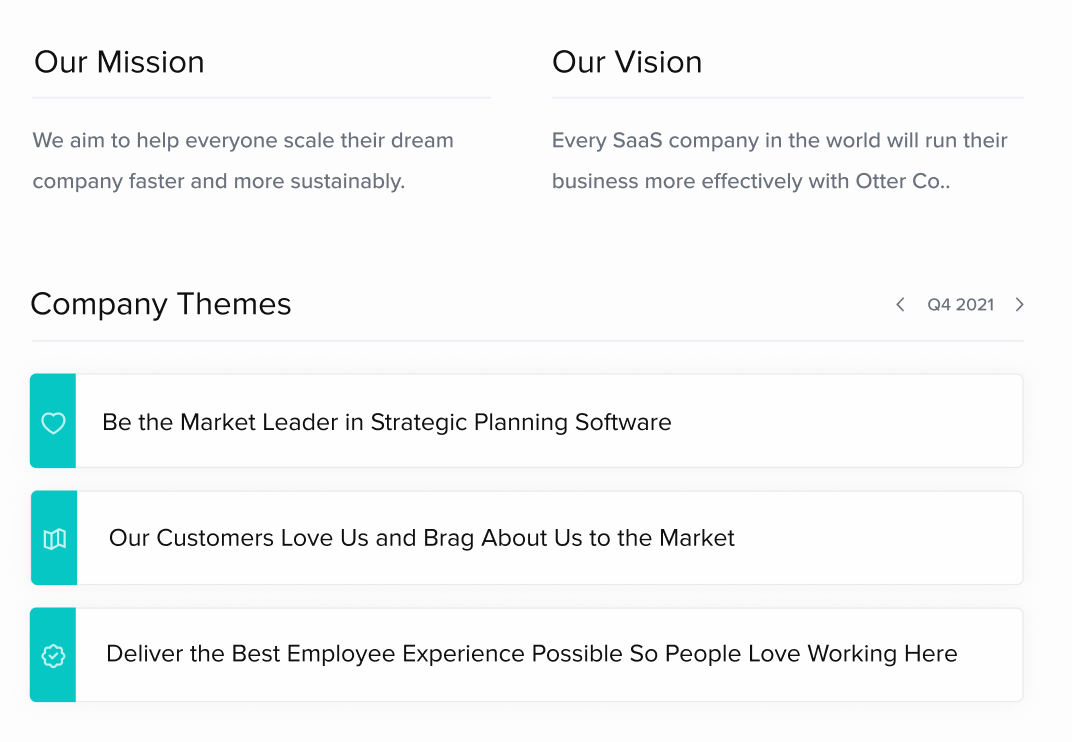
The process of implementing OKRs for the first time at a company is easier said than done. Although past experience can be helpful for any strategy and operations leader tasked with implementing OKRs, any time you're introducing a new operating framework for your company it can be challenging. And as we've shared before, implementing OKRs requires an understanding of the long-term value and buy-in that the process will continue evolving as your company grows.
From working alongside some of the leading strategy and operations leaders today, our team wanted to highlight three key takeaways we've seen help successfully implement objectives and key results at a company for the first time.
Establish Accountability at the Leadership Level
If you ask a number strategy and operations leaders what one of the most common challenges would be in implementing OKRs, executive buy-in and support would be towards the top of the list. However, we have yet to see an OKR framework implemented that didn't first start with approval or acceptance by an executive team.
Sure there might be an executive or two who pushes back on the framework because of bad experiences in the past, but that isn't just about OKRs. Whether it’s OKRs, V2MOM, EOS, or any other goal-setting framework, those same executives or others will still have pushback.
Far too many executives have seen the false starts and pain associated with rolling out any type of goal-setting framework to believe it will be a silver bullet for solving the challenges that come with growth. And we would agree.
At Elate, we believe in a three-tiered approach to implementing a strategic plan that incorporates a goal-setting framework: people, process, and tools.
Without any one of these legs of the stool, you’re bound to fail. That's why it's critical to have the right process in place at the leadership level for a framework like OKRs to take hold. And for as simple as it might sound, it’s actually one of the most commonly overlooked steps in any guide to OKRs or OKR planning document.
After your leadership team spends hours proposing, reviewing, and finalizing OKRs for a quarter, there should be an agreed upon rhythm and cadence for how your company is communicating at all levels. Further, there should be agreement on how often you are meeting to review objectives as a leadership team. And these shouldn’t be optional rhythms that are abandoned the moment scheduling becomes difficult or leaders start to bail.

In fact, it’s more important that leadership stays committed to an operating framework, because the moment leaders start seeing it as optional, your other employees will as well.
Often, we see the most common rhythm agreed upon is in your weekly or bi-weekly executive team meetings. Rather than go through the motions of talking about what's going on in the business at a surface level or even just spending precision time focusing on the most recent fire that might not be a true priority, these meetings should have a structure that prioritizes the objectives agreed upon for the quarter. These meetings start with a simple status of where each objective stands, the key results impacting your company's overall performance, and any topics related to these objectives that need to be discussed.
By establishing clear, consistent cadence for following through on your OKRs, you can help ensure that your company's commitment to the framework stays intact.
Start with the Why for Employees
Believe it or not, most employees likely don't know much about OKRs. For those of us that live and breathe in the world of company priorities and objectives, we've likely read Measure What Matters, reviewed countless articles on OKR best practices, and even had multiple debates internally on the difference between an OKR vs KPI. (Hint - you can have both)
However, this knowledge can cause us to overlook the simple fact that many employees have never been given the opportunity to build their own objectives that align with the company's overall direction.
So keeping this in mind, when you are ready to roll out OKRs to your organization, we always recommend starting with a guided tutorial explaining why you are asking employees to build a new rhythm into their week.
And don't be fooled, even if it's as simple as providing a weekly update via Slack or even automating it from data pulled through integrations, employees will see this as just another thing they have to do. Unless of course, they understand the 'why' behind it.
At Elate, we often build custom training sessions for companies to walk through an overview of the OKR methodology, how it's relevant to your company, and even share your specific company’s OKR examples. This helps align folks around the vision and direction for the company, and construct OKRs in a meaningful way.

Establish How Your Company Sets OKRs from the Onset
Maybe the most important, but often overlooked part of setting OKRs is first setting a universal standard for what OKRs should represent at your company. Just as important as the 'why' behind the OKR process itself is the 'how' behind setting and measuring OKRs.
For some companies, OKRs are meant to be attainable, almost expected. We work with companies that aim to reach 100% attainment of OKRs, because they set them as foundational goals that the company expects to achieve.
For others, OKRs are ultra aggressive. They are meant to be hard to attain, and success can be reaching 75% of key results for an objective.
In choosing either of these options, or even if you use a blend of the two models, you should be sharing example OKRs during your training with employees so they understand how to build their own OKRs. From what we've seen at Elate, the most important part of the process of building OKRs is ensuring you communicate and set proper expectations with employees, and provide OKR examples that align with what you expect to see.
Interested in Learning About Implementing OKRs for Your Company?
If you and your team are evaluating implementing a goal-setting like OKRs heading into Q4 or 2022, we'd love to share more about the work we are doing at Elate and how we are partnering with strategy and operations leaders from leading companies today.
Although it can be overwhelming to think about what it looks like to implement OKRs amidst all of the other chaos and change going on at your business, we promise, you won't regret it.


